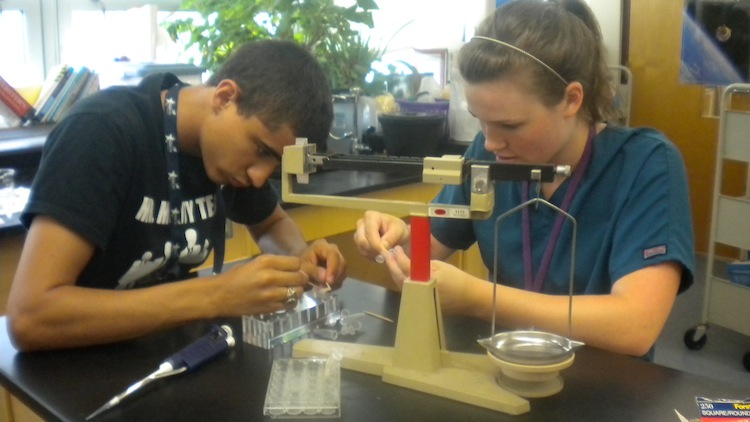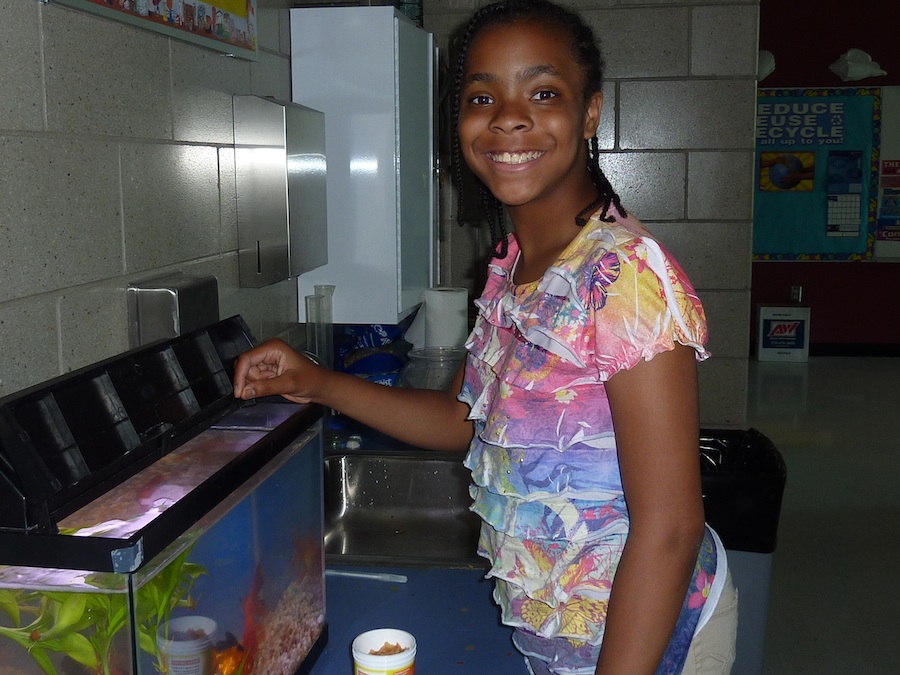
Last update to this page: August 26, 2020
The Student Spaceflight Experiments Program (SSEP) was launched in June 2010 by the National Center for Earth and Space Science Education in strategic partnership with NanoRacks, LLC. It is a remarkable U.S. national Science, Technology, Engineering, and Mathematics (STEM) education initiative that gives typically 300+ students across a community – upper elementary, middle, or high school students (grades 5-12), or undergraduates at 2-year or 4-year colleges and universities (grades 13-16) – the ability to design and propose real microgravity experiments to fly in low Earth orbit, first aboard the final flights of the Space Shuttle, and then on the International Space Station (ISS)—America’s newest National Laboratory.
 More broadly, SSEP is about a commitment to student ownership in exploration, to science as journey, and to the joys of learning. For school districts—even individual schools—it provides an opportunity to implement a systemic, high caliber, and historic STEM education program tailored to community need.
More broadly, SSEP is about a commitment to student ownership in exploration, to science as journey, and to the joys of learning. For school districts—even individual schools—it provides an opportunity to implement a systemic, high caliber, and historic STEM education program tailored to community need.
SSEP is about immersing and engaging students and their teachers in real science—on the high frontier—so that students are given the chance to be scientists—and experience science firsthand.
Most of the links in the program summary below are to the 1) SSEP main website that provides an overview of the program, how to participate, and all resources in support of program operations, and 2) the separate SSEP Community Network Hubsite that provides an overview of the participating communities, the scope of the program at the local level, the experiments flown, and the over 1,150 organizational partners.
 Each community participating in SSEP conducts a local Flight Experiment Design Competition with their student teams vying to fly an experiment in low Earth orbit in a real research mini-laboratory reserved just for their community. Mirroring how professional research is done, student teams across the community submit formal research proposals, which then go through a 2-step proposal review process to select the flight experiment for the community. Your design competition—from program start, to experiment design, to submission of proposals by your student teams—runs a minimum of 8 weeks. Students can design experiments in diverse fields, including: seed germination, crystal growth, physiology and life cycles of microorganisms (e.g. bacteria), cell biology and growth, food studies, and studies of micro-aquatic life. Content resources for teachers and students support foundational instruction on science in microgravity and experimental design. A suite of SSEP program elements—the Community Program—leverages the flight experiment design competition to engage the entire community, embracing a Learning Community Model for STEM education, and allows the experience to be celebrated with national, even global audiences.
Each community participating in SSEP conducts a local Flight Experiment Design Competition with their student teams vying to fly an experiment in low Earth orbit in a real research mini-laboratory reserved just for their community. Mirroring how professional research is done, student teams across the community submit formal research proposals, which then go through a 2-step proposal review process to select the flight experiment for the community. Your design competition—from program start, to experiment design, to submission of proposals by your student teams—runs a minimum of 8 weeks. Students can design experiments in diverse fields, including: seed germination, crystal growth, physiology and life cycles of microorganisms (e.g. bacteria), cell biology and growth, food studies, and studies of micro-aquatic life. Content resources for teachers and students support foundational instruction on science in microgravity and experimental design. A suite of SSEP program elements—the Community Program—leverages the flight experiment design competition to engage the entire community, embracing a Learning Community Model for STEM education, and allows the experience to be celebrated with national, even global audiences.
|
“This whole thing is so unbelievable. We are doing real science research that really matters. What we design will really fly in space aboard the very last space shuttle mission. This could be a life-changer for me. It is something that I will someday tell my grandkids about. How cool!” |
Key Program Objectives:
• Immerse students in real science, including the design of real experiments constrained by the operation of a microgravity mini-laboratory and flight operations to and from Low Earth Orbit; submission of formal proposals by student teams; formal selection of flight experiments through a 2-step proposal review process; a formal NASA flight safety review for the selected flight experiments; and a research conference at the Smithsonian’s National Air and Space Museum, in Washington, DC, for reporting of experiment results.
• Provide a national model for a true STEM education program that embraces student ownership in learning, and broad interdisciplinary connections.
• Provide an authentic view of science that has the ability to change perceptions about the nature of science for students and the public; and the nature of science education for teachers.
• Use the excitement of real science on the high frontier to engage entire communities of students, teachers, and families.
Program Highlights:
Since program inception in June 2010, there have been fifteen SSEP flight opportunities—SSEP on STS-134 and STS-135, which were the final flights of Space Shuttles Endeavour and Atlantis; and SSEP Missions 1 through 13 to ISS. A total of 178 communities have participated in the program, reflecting 41 States and the District of Columbia in the U. S., 4 Provinces in Canada, and a community in Brazil. Thus far 52 communities have participated in multiple flight opportunities – one community is even conducting their 9th flight with Mission 13 – reflecting the sustainable nature of the program.
Through the first fifteen flight opportunities (through Mission 13), a total of 109,950 grade 5-16 students across 2,192 schools were fully immersed in microgravity experiment design and proposal writing, 22,442 flight experiment proposals were received from student teams, and 281 experiments were selected for flight. Through Mission 13, 147,400 students across the entire grade preK-16 pipeline were engaged in their communities’ broader STEAM experience, submitting 120,670 Mission Patch designs.
All 240 experiments selected for flight through Mission 12 have now flown. The Mission 12 experiments returned to Earth on August 3, 2018. Another 41 experiments are expected to launch in Summer 2019 as the Mission 13 Gemini payload of experiments on SpaceX-18, launching from Kennedy Space Center, FL.
MARCH 2019: NEW OPPORTUNITY ANNOUNCED
SSEP Mission 14 to ISS
The sixteenth SSEP flight announcement of opportunity—for Mission 14 to ISS—provides for an experiment design competition Fall 2019, and a ferry flight to ISS in Spring 2020. Mission 14 to ISS is open to school districts and schools across the U.S. (grades 5-12); 2-year community colleges and 4-year colleges across the U.S.; communities in the U.S. led by informal education or out-of-school organizations; and international communities in European Space Agency (ESA) member nations, European Union (EU) member nations, Canada, and Japan, through the Arthur C. Clarke Institute for Space Education—the international arm of the National Center for Earth and Space Science Education.
Intrigued? Visit the SSEP Main Website for full program details, or Contact Us.
Strategic, National and Local Partners:
The Student Spaceflight Experiments Program (SSEP) is overseen by the National Center for Earth and Space Science Education (NCESSE). SSEP is enabled through a strategic partnership with NanoRacks LLC, which is working with NASA under a Space Act Agreement as part of the utilization of the International Space Station as a National Laboratory. NCESSE and NanoRacks are therefore designated SSEP Strategic Partners. To read about the programmatic roles and responsibilities of the SSEP Strategic Partners, visit the SSEP Team page.
The National Center for Earth and Space Science Education is proud to be partnering on SSEP with the Smithsonian’s National Air and Space Museum and the Center for the Advancement of Science in Space (CASIS), both designated SSEP National Partners. To read more about these partnerships, visit the National Partners page at the main SSEP Website.
Partnership is truly a hallmark of SSEP. Over 1,150 organizations support SSEP at the local level, including: school districts, private schools, NASA Space Grant lead institutions and other universities, corporate foundations, businesses, community foundations, and local research institutions. These organizations are designated the SSEP Local Partners. To explore the Local Partners, visit the Communities & Local Partners page.
Other Student Spaceflight Experiments Program pages of interest:
SSEP Participating Communities and Local Partners
Student Experiments Selected for Flight
SSEP In the News
Program Impact from Teachers, Students, and Community Leaders
Mission Patches Flying with Flight Experiments
SSEP National Blog for complete program news
SSEP Annual National Conference at the Smithsonian National Air and Space Museum
How to Participate:
Carefully read the SSEP Home Page and contact the National Center for Earth and Space Science Education.
